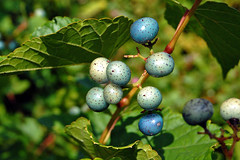Dumbarton Oaks Park was once part of the fabulously planned and meticulously maintained gardens of a splendid estate in north Georgetown, Washington, D.C. In 1940, the owners, Ambassador Robert and Mildred Woods Bliss deeded the formal gardens and hilltop mansion to Harvard University. The lower, "more naturalistic" 27 acres they generously gave to the U.S. government for a park for the American people.
 Porcelain-berry (Ampelopsis brevipedunculata), a highly invasive non-native vine, produces a colorful display of fruit.
Porcelain-berry (Ampelopsis brevipedunculata), a highly invasive non-native vine, produces a colorful display of fruit.
Photographer: Flickr user Peter Gorman.Although the grounds that are now a unit of Rock Creek Park had been intended to maintain the look of a natural woodland, non-native vines such as Japanese honeysuckle and periwinkle had been planted among the natural features as part of the original grand design. Some of these plant species turned out to be aggressive invaders. Moreover, ornamental plantings from the estate’s formal gardens uphill have seeded themselves into this stream valley. By the beginning of the 21st century, meadows and woodlands were infested with non-native vegetation that threatened to keep spreading, including porcelain-berry, bush honeysuckle, and English ivy.1 2
Volunteers, in partnership with the National Park Service and others, launched efforts to return Dumbarton Oaks Park to a truly naturalistic state. YOU can help with this sustainable restoration plan that began when Dumbarton Oaks Park Conservancy formed in 2010.


